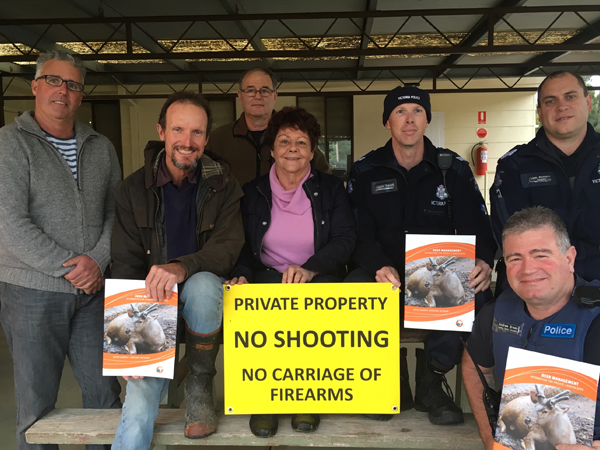Monitoring and awareness leads to local solutions for deer management
By Upper Murray Landcare
One of the main biosecurity issues Victorian landholders in the Upper Murray region identified is the spread of wild deer who cause destruction on many properties.
Since 1997, the landholders have been involved in a catchment planning process, initiated by the Upper Murray Farm Tree group and Landcare groups. The presence of wild deer was noted as having minimal impact at the time – but by 2013, the situation had changed dramatically. Deer were identified by land managers as a pest animal in the agricultural and forest landscape, wreaking havoc on fences, pastures, and water quality.

From left: Joe August, Tony Jarvis, Ross Cooper, Lyn Coulston, Constable Justin Tyers, Sargent Liam McMahon, and Leading Constable Andrew Green.
One consequence of large deer numbers was the increase in illegal shooting. Entry onto private land and the use of firearms around stock, shooting from roadsides, and the presence of deer carcasses left behind, was unacceptable to the local community and raised safety concerns.
The Upper Murray Landcare Network convened a Deer Management Information Forum and workshop in September 2015 to hear about the status of deer, the role of government and hunting associations, and identify local concerns to find out what land managers needed for better management of deer on private property and public land.
It was an open forum with speakers from the Game Management Authority, Australian Deer Association, Victoria Police, Parks Victoria and the Department of Environment, Land, Water and Planning who then participated in a workshop with the 75 attendees.
The presentations and deliberations at the forum resulted in key priorities:
- A central source of information for deer management on private land. Unreliable or no internet service and demographics were identified as a barrier to sourcing online information from different websites.
- Management options for reducing deer numbers.
- Legislation change to enable removal of deer carcasses after culling.
- Better management of illegal shooting and antisocial behaviour.
As a result, a deer management information folder was prepared as a resource for private land managers. ‘Private Property’ and ‘No Shooting’ signs were produced and ‘Rural Watch’ set up, an informal network where antisocial behaviour is notified within the network of neighbours and to emergency services. Policy makers have been engaged to initiate legislative changes to allow carcass removal. The actions of the community to tackle the problem of wild deer demonstrates the benefits of having long-term goals and broad community engagement.
Rather than waiting for someone else to act, which causes frustration and delays, it is appropriate for people to find their own solutions, tailored to their needs. Collaboration at ground level produces a practical resource. Advocacy and collaboration at a government level seeks to address more complex issues.
The journey from 1997 to 2017 demonstrates that when a community is aware of real and emerging threats, the outcomes can be influenced by taking local action.



